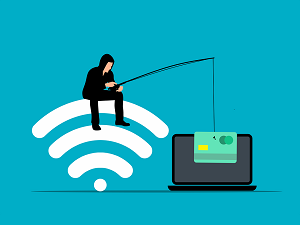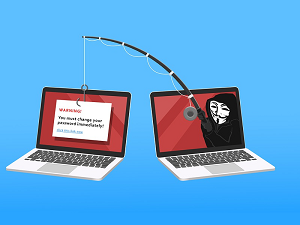A Comprehensive Guide for Business Owners and Entrepreneurs About Fake Invoices
 Entrepreneurs and business owners face an increasing array of cyber threats, with invoice fraud being one of the most pervasive. Running a business involves receiving and paying many invoices, and while your accounts payable department likely follows defined processes to ensure transactions go smoothly, the rise of sophisticated invoice fraud schemes should put every business owner on high alert. Recent reports indicate that scams and fraud involving false invoices increased by a staggering 137.5% in 2023.
Entrepreneurs and business owners face an increasing array of cyber threats, with invoice fraud being one of the most pervasive. Running a business involves receiving and paying many invoices, and while your accounts payable department likely follows defined processes to ensure transactions go smoothly, the rise of sophisticated invoice fraud schemes should put every business owner on high alert. Recent reports indicate that scams and fraud involving false invoices increased by a staggering 137.5% in 2023.
Given the financial impact and the sophisticated techniques fraudsters use, business owners need to stay informed and take proactive measures to protect their companies. Knowing how to detect invoice fraud is crucial for preventing financial losses that can cripple even the most established businesses. In this guide, we’ll dive into what invoice fraud is, the tactics scammers use, and, most importantly, how you can safeguard your business from these growing threats.
 What Is Invoice Fraud?
What Is Invoice Fraud?
Invoice fraud is a deliberate attempt by cybercriminals to steal money from a company by submitting a fake or manipulated invoice. Fraudsters may pose as legitimate vendors, alter existing invoices, or create completely fictitious bills in an effort to exploit weaknesses in a company’s accounts payable process. The goal is simple: to receive payment for services or goods that were never provided or to divert legitimate payments to their accounts.
Common invoice fraud tactics include:
- Fake invoices from non-existent companies: Fraudsters create completely fictitious invoices and send them to businesses, hoping the accounts payable department won’t verify the vendor.
- Billing for non-existent products or services: In this tactic, invoices are generated for products or services that were never ordered or delivered.
- Overcharging or inflating costs: The scammer alters legitimate invoices by increasing the amount owed, hoping the overcharge goes unnoticed.
- Invoice redirection or payment diversion: Fraudsters alter payment details on a legitimate invoice, diverting the payment to their accounts.
- Sending extra invoices for small amounts: Some scammers submit additional invoices with small charges, assuming these will be paid without much scrutiny.
These fraudsters count on the fact that many businesses, especially those handling a high volume of transactions, may not have the time or resources to meticulously review every invoice. As a result, fraudulent invoices can slip through the cracks, causing significant financial damage over time.
Phishing: A Common Invoice Fraud Tactic
Phishing is one of the most prevalent techniques fraudsters use to facilitate invoice fraud. In phishing schemes, scammers exploit the trust businesses have in their vendors. They create fake invoices from what appear to be legitimate vendors and send them via email, often from addresses that look very similar to the real vendor’s. These fraudulent emails usually contain a sense of urgency, pressuring the recipient to pay the invoice quickly without taking time to verify its authenticity.
A common phishing scenario involves the fraudster impersonating a vendor, sending an email claiming that their payment remittance information has changed. If your accounts payable team falls for this trick and updates the payment details, your company could end up transferring money directly to the scammer's account.
The Consequences of Invoice Fraud
Invoice fraud can have severe consequences for businesses of all sizes, including:
- Financial loss: Paying fraudulent invoices can lead to significant financial losses. If scammers repeatedly exploit your accounts payable process, the losses can compound over time.
- Damage to vendor relationships: If a payment is misdirected to a scammer instead of a legitimate vendor, it can strain your relationship with that vendor, leading to disputes or delays in service.
- Loss of trust: Falling victim to invoice fraud can damage your company’s reputation, eroding the trust of customers, investors, and partners.
- Legal consequences: Depending on the industry, businesses that fail to implement proper fraud prevention measures could face regulatory fines and legal repercussions for not safeguarding sensitive financial information.
 How to Protect Your Business from Invoice Fraud
How to Protect Your Business from Invoice Fraud
The good news is that there are proactive steps you can take to protect your business from falling victim to invoice fraud. By implementing best practices and using technology, you can dramatically reduce the risk of fraudulent invoices slipping through your system.
1. Educate Your Employees About Invoice Fraud and Phishing Scams
One of the most effective ways to prevent invoice fraud is by educating your employees, particularly those in the accounts payable department, about common fraud tactics. Training your staff to recognize phishing emails, fake invoices, and unusual payment requests is critical. A well-informed team is your first line of defense against fraud.
Key signs that an invoice may be fraudulent include:
- Grammatical or spelling mistakes: Fraudulent invoices often contain subtle errors that can be a red flag.
- Small differences in contact details: Fraudsters may use emails or phone numbers that closely mimic the real vendor’s information, but small inconsistencies may give them away.
- Discrepancies in invoice appearance: If an invoice looks different from previous invoices you’ve received from the same vendor, it could be a sign of tampering.
- Unusual payment demands: Be wary of invoices that include unexpected bills, urgent payment requests, or instructions to remit payment to a new or unfamiliar bank account.
 2. Implement a Multi-Step Invoice Verification Process
2. Implement a Multi-Step Invoice Verification Process
Don’t rely solely on your accounts payable team to spot fraud manually. Create a multi-step verification process that requires multiple approvals before a payment is released, especially for high-value invoices. This may include verifying the legitimacy of the vendor, confirming the receipt of goods or services, and cross-referencing the invoice with purchase orders and contracts.
Any sudden changes in payment remittance details, such as a new bank account or different payment instructions, should trigger an additional level of scrutiny. Confirm changes with the vendor through known contact information, rather than relying on details provided in the email or invoice.
3. Leverage AI and Automation to Prevent Invoice Fraud
While manual reviews are effective to some extent, they can be time-consuming and prone to human error. This is where artificial intelligence (AI) and automation can significantly improve your fraud detection efforts. AI-powered accounts payable tools can automatically flag suspicious invoices based on patterns and anomalies, such as changes in vendor information, duplicate payments, or mismatches between invoice details and purchase orders.
AI can also be used to streamline the invoice matching process, ensuring that only legitimate invoices are paid. By automatically comparing invoices with purchase orders and delivery receipts, AI systems can detect discrepancies that might otherwise go unnoticed. With machine learning capabilities, these systems continuously improve, becoming better at identifying potential fraud as they process more data.
4. Use Payment Gateways with Built-In Fraud Detection
Another way to reduce the risk of invoice fraud is to use secure payment gateways that offer built-in fraud detection features. Many modern payment platforms provide advanced fraud detection tools, including transaction monitoring, encryption, and authentication protocols, which can help prevent unauthorized payments.
These tools can flag unusual payment activity, such as invoices paid to unfamiliar accounts, or multiple invoices from the same vendor within a short period. By leveraging secure payment gateways, you can add an extra layer of protection to your accounts payable process.
5. Monitor Vendor Relationships and Payment Trends
Regularly reviewing your vendor relationships and payment trends can help you identify unusual activity that may indicate fraud. Set up a system to monitor vendor accounts, track payment history, and flag any deviations from the norm. If a vendor suddenly starts issuing invoices with different payment instructions or you notice an uptick in small, questionable invoices, investigate these discrepancies promptly.
6. Verify All Payment Changes with Vendors Directly
Fraudsters often attempt to intercept legitimate invoices and alter the payment details, hoping that your accounts payable team will not notice the change. Always verify any changes to payment remittance information with your vendor using a trusted communication channel. Contact the vendor directly through phone or an official email address, rather than responding to the email that contained the invoice.
Let's Recap
Invoice fraud is a growing threat to businesses, and its impact can be devastating. As a business owner or entrepreneur, it is your responsibility to ensure that your company is protected from fraud-related financial losses. By educating your employees, implementing a robust verification process, leveraging AI-driven tools, and using secure payment gateways, you can significantly reduce the risk of falling victim to invoice fraud.
The rising tide of cyber threats means that no business is immune. Taking proactive steps now can help safeguard your company’s financial stability and protect your hard-earned reputation. If you’re ready to explore how advanced technology can secure your payment processes and protect your business from invoice fraud, contact CTTS today to learn more about our comprehensive IT and cybersecurity solutions.
